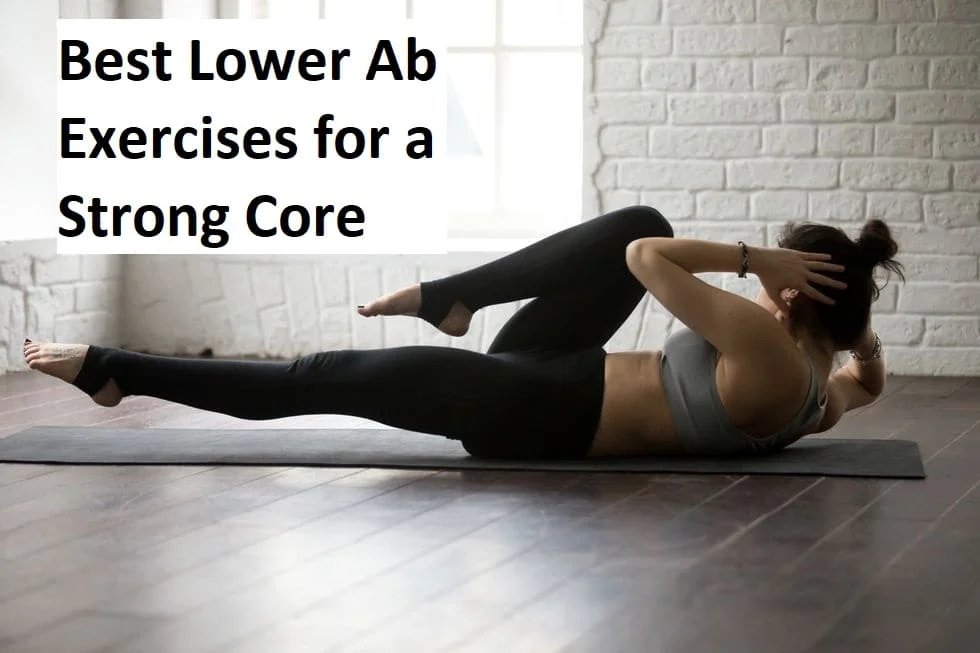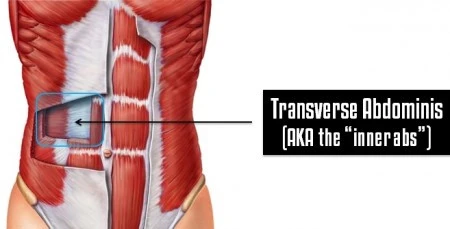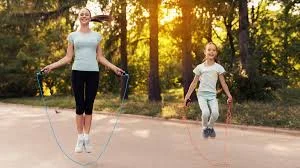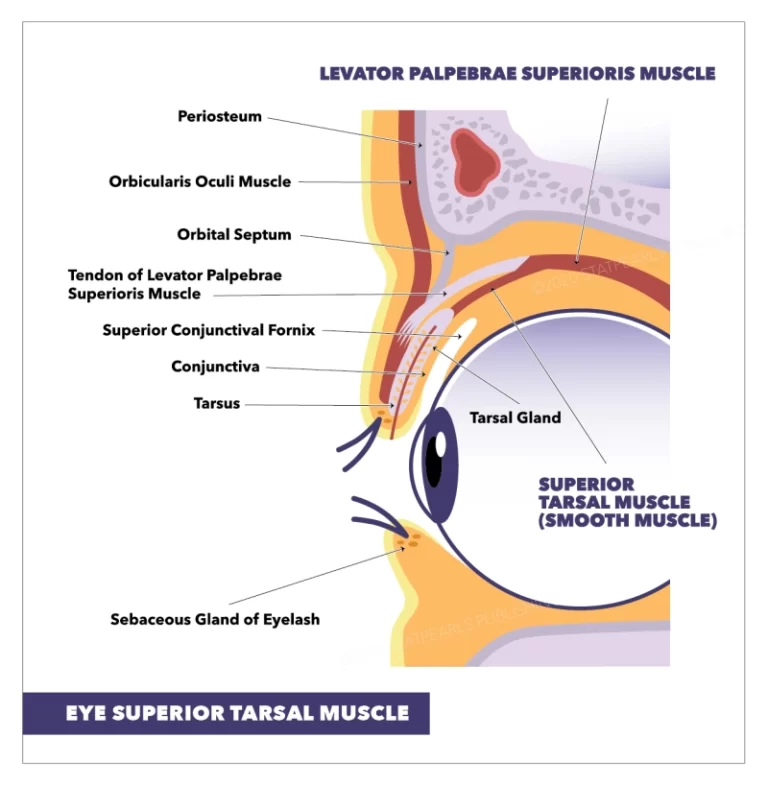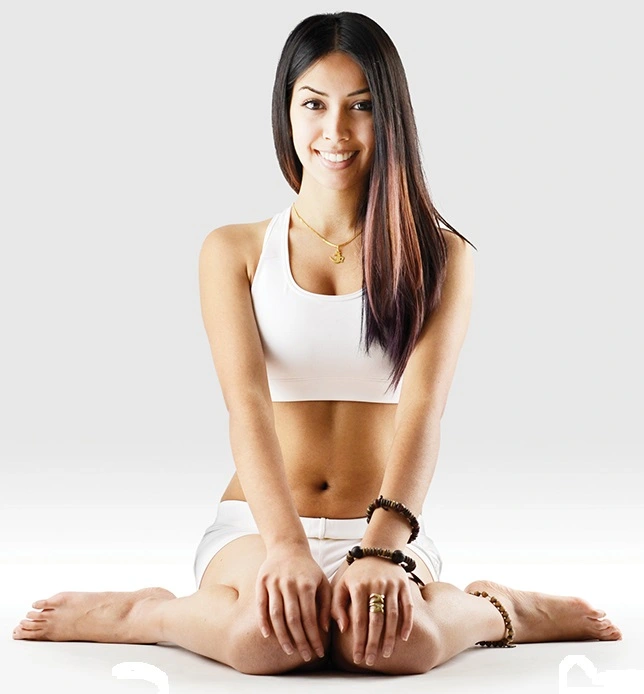29 Best Lower Ab Exercises for a Strong Core
Lower ab exercises specifically target the muscles in your lower abdominal region, helping to achieve a well-rounded core. A strong core is essential for overall strength, stability, and posture.
In this guide, we’ll explore some of the best lower ab exercises to help you build a strong and functional core. These exercises will not only enhance your physique but also improve your overall physical performance and reduce the risk of lower back pain and injury.
What is Lower Abdominal Muscle?
The lower abdominal muscles, also known as the lower abs, are located in the lower part of the abdomen. They are responsible for stabilizing the pelvis and lower back, supporting the internal organs, and helping to maintain good posture.
There are several muscles that make up the lower abs, including:
- Rectus abdominis: This is the largest muscle in the abdomen and runs vertically from the pubic bone to the sternum. It is accountable for the flexion of the trunk and compressing of the abdomen.
- Transversus abdominis: This muscle runs horizontally across the abdomen and is responsible for stabilizing the pelvis and spine.
- Internal obliques: These muscles are located on either side of the rectus abdominis and are responsible for rotating and flexing the trunk.
- External obliques: These muscles are located on either side of the rectus abdominis and are responsible for rotating and bending the trunk.
To effectively target the lower abs, exercises such as leg raises, reverse crunches, and bicycle crunches can be performed. It is important to engage the core muscles throughout these exercises to ensure proper form and avoid injury.
Lower abdominal exercise
V-Sits
The V-sit ab exercise works various areas of your core and also builds abdominal strength while challenging your balance. in order to perform this exercise, make a V shape with your body, raise your torso off the floor, and extend your legs in an upward direction.
In case you are a beginner, you can make changes in this movement by using your hands to provide support or bending your legs a little at the knee to do a knee tuck.
To do this exercise:
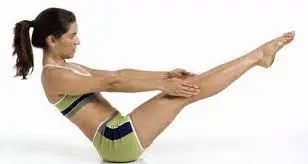
- Start with a seated position and your feet and hands should be on the ground.
- During contracting your core, gradually raise your legs to an extended position, and form a forty-five-degree angle with your torso.
- As long as it feels good for your body, extend your arms straight forward or upward toward your shins.
- Make sure you keep a good core posture and a strong spine during the whole movement and do not do rounding of the shoulders.
- Though holding your breath is normal, keep reminding yourself to breathe.
- Begin by keeping this position for several seconds until your body gets fatigued.
- You will be able to maintain the position for longer as you get more comfortable with the movement.
- With the care go back to your beginning position while maintaining your abdominal muscles engaged in an activity.
- Pause and keep the position for several seconds before relaxing your body to the ground.
- Do it again this movement 20 to 25 times.
Reverse Crunches
An alternative to the traditional abdominal crunch exercise is the reverse crunch. In this exercise, your legs are brought closer to your chest by contracting your core while your upper body stays on the mat.
This exercise hits the hard-to-reach lower abs by targeting the entire rectus abdominis muscle. This exercise is a perfect complement to any core training because it simply requires your body weight.
To do this exercise:
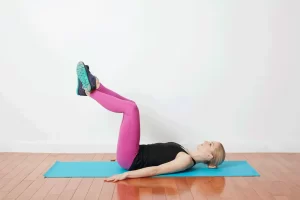
- Start with lying face up, place your legs in a tabletop position, your knees should be bent, and stack them above your hips.
- Bend your elbows so they point out to the side while placing your hands behind your head, or place them on the floor close to your torso for more support.
- Engage your abs to take your shoulders off the ground.
- This will be your beginning position.
- Pull your knees in toward your chest as you slowly raise your hips off the ground while keeping your abdominal tight.
- With care lower your hips and legs back to the beginning position.
- Perform 8 to 10 repetitions.
- Do 2 to 3 sets.
Pilates Scissors
This Pilates scissor exercise works well for toning the obliques and upper and lower abdominal muscles. Your hip flexors and hamstrings will both get a good workout from the crisscross motion.
To do this exercise:
- Initiate on your back and your knees should be bent, and place your feet on the ground.
- Make sure you breathing deeply, and firmly plant the backs of your arms and shoulders into the mat.
- Your body should be in an upside-down position with your weight resting on your shoulders while you pull your knees toward your chest and lift your hips off the mat.
- Hold the back of your pelvis with your hands, your elbows should be directly under your hips.
- Do the extension of your hips and your legs, maintaining your legs together.
- As you sustain yourself in this inverted posture, imagine yourself extending your body.
- Make sure your neck is long and your chest should be open.
- In case you need to modify, drop your shoulders to get more support from the backs of your upper arms.
- Spread your legs and move them in a scissoring movement away from each other.
- Do not overextend the overhead leg.
- Make sure you keep your pelvis stable.
- Do again the scissor motion for six times per set.
Double Leg Lifts
Your hip flexors, as well as the muscles in your upper and lower abdomen, are worked during this complex double-leg lift exercise. Additionally, you’ll engage the gluteal and quadricep muscles in your buttocks and front of your thighs. While performing this exercise correctly, you should inhale deeply toward your sides and back.
To do this exercise:
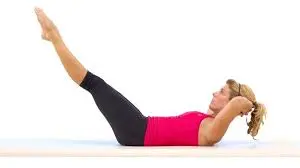
- Start with lying flat on your back, begin by extending your legs up in the direction of the ceiling.
- Maintain your heels closer and turn your legs out a little, pointing your toes.
- Maintain your hands behind your head, ensure your elbows are wide and your chest is open.
- Do the deep inhalation.
- On the exhalation, pull your abdominal muscles to the ground.
- Your upper body will curl up off the floor as a result of the motion pressing your lower back into the mat.
- This is the beginning position.
- Maintain your abdominals pulled in and your back should be pressed into the mat.
- Do lengthen your legs from your hips, dropping them gradually.
- As a variation, you may lower the legs in three different stages.
- Always remember that the dropping movement should take longer time than the raising motion.
- Lower your legs as far as you can while still keeping proper alignment, then hold there.
- Do the exhalation, raise your legs upright in a controlled motion, and maintain the abdomen contracted.
- Make sure your elbows are broad and your chest is open by checking your posture.
- Do this exercise for six to eight times.
Bicycle Crunches
The obliques and lower abdominal muscles are both well-targeted by the bicycle crunch. All you need for this beginner move is a mat. You are using your deep abdominal muscles the entire time because your legs are lifted during the activity.
To do this exercise:
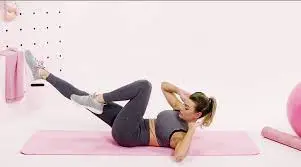
- Start with lying face up and your legs should be in a tabletop position.
- Initiate by keeping your hands back side of your head with your elbows bent and pointing out to the sides.
- Using your abs, curl your shoulders off the ground. This is where everything begins.
- Do the twisting of your body and take your right elbow to your left knee, one by one straightening your right leg.
- After that twist take your left elbow to your right knee, one by one straightening your left leg.
- Try to feel your abs working by moving slowly focusing on the muscle and regulating the twist.
- Do 15 to 20 repitations.
- The goal is for 3 to 4 sets of exercises.
Bird-Dogs
The bird-dog is a bodyweight exercise that tones the glutes, lower back, and abdominal muscles. Since you will be using your own body weight as resistance during the exercise, all you need is a mat.
Anywhere that gives you enough space to extend your arms and legs and a comfortable spot for your hands and knees can be used for bird-dog poses. During this exercise, your core will be engaged as you employ your stability muscles to keep your balance.
To do this exercise:
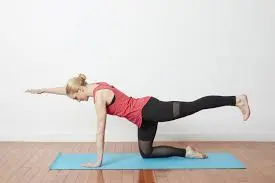
- start with kneeling on your knees at a hip-width distance and your hands should be pressed against the mat at about a shoulder width away.
- Do the contraction of your abdominals.
- Raise one hand and its opposing knee about an inch above the ground while maintaining balance with the other hand and knee to acquire a sense of the motion.
- Put your weight in the middle.
- When you experience steady enough to attempt a full range of motion, Do the extension of one arm straight in front of you, with the opposite leg behind you.
- Your hips should be square and your body should make a straight line from hand to foot.
- To stop your lower back from sagging, contract your abs.
- Maintain this movement for a few seconds before returning to your hands and knees.
- Change to the other side.
- Maintain your abdominal muscles engaged during the whole movement.
- Prevent from using momentum to complete the repetitions, rather, slow down as necessary to keep your posture correct.
- Make sure you complete five repetitions on each side for a total of 10 repetitions per set.
- The goal should be for three sets total.
90-Degree Static Press
When you want to fit in an extra lower abdominal workout, this is the ideal exercise to do as a stand-alone or to warm up your core at the start of your workout.
To do this exercise:
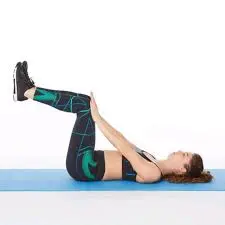
- Start with lying face up and knees and hips should be bent at ninety degrees, and feet should be in flexion.
- Do the Extension of arms and press both palms on top of thighs.
- Inhale deeply, and as you release the breath, contract your abs, press your lower back against the floor, and squeeze your thighs into your hands, pressing back against them.
- do not move your legs.
- Maintain for 1 count and then release.
- Perform up to 3 sets of 10 repetitions in a row.
In order to make it more challenging raise your head and shoulders off the ground as you press your thighs and palms together while you do the exhalation.
drop your upper body back down to the ground as you inhale.
Resisted Single-Leg Stretch
This Pilates-inspired exercise intensifies your abdominal activation by using the same pushing motion as the static press. This workout for your low abs is more difficult because of the weight of your extended leg.
These Exercise and Nutritional Changes Could Help You Reduce Abdominal Fat and Boost Your General Health
To do this exercise:
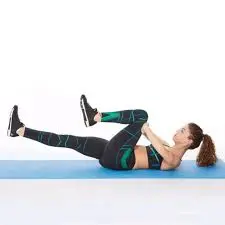
- Start with lying on your back and bend both knees into your chest, feet should be flexed.
- Stretch your left leg out parallel to the floor while you interlace your fingers across your right thigh.
- Raise your head and shoulders off the ground, curling up over the top of the ribcage and looking at your legs.
- Your hands should give resistance to your leg as you press them against your right thigh and tilt your pelvis to bring your right knee closer to your chest.
- Change to another leg and press palms against the left thigh as a right leg in extension parallel to the ground.
- That is 1 repetition.
- Perform three sets of ten repetitions consecutively.
To increase difficulty, maintain a straight posture with both legs pressed against the top of the thigh as one leg pulls in. Then, alternate sides by scissoring back and forth.
U-Boat
Even though this exercise is simple, it has a significant positive impact on your lower abdominals.
To do this exercise:
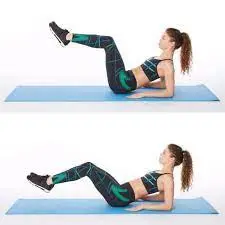
- Start with sitting knees bent, feet should be flat on the floor.
- tilt back to prop your upper body up on elbows, your back should remain raised, palms facing down.
- Tighten your abs and raise your legs to a 90-degree inclination.
- knees should be touching, toes pointed.
- With both hips remaining on the surface of the floor, gradually move your legs to the left.
- Keep the 90-degree angle with legs, and lower legs and then lift them up to the right, as if you were tracing a letter “U” with your knees. That is 1 repitation.
- Do 20 repetitions total, alternating sides each time.
Make it harder: This becomes more difficult the longer the lever is, so if you’re up for a challenge, try stretching your legs further apart—you could even attempt straightening them out entirely.
Reverse Plank Hover
You should incorporate this much harder-than-it-looks exercise into your lower ab routine. All of your body’s muscles, including your abs, will be worked out.
To do this exercise:
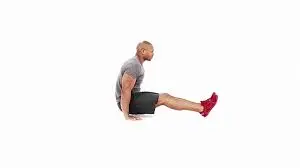
- Start with sitting and your legs should be extended, feet flexed, and hands should be placed just outside your hips with your fingertips facing your forward.
- To raise your hips a few inches off the ground, tighten your core and apply pressure with your arms.
- Slightly bend your knees, and hold your heels on the floor.
- As you exhale, completely stretch your legs and attempt to press your hips slightly behind your shoulders. Inhale and draw your abs in closer to your back.
- Maintain it for 1 count.
- To gently lower yourself to the floor, bend your knees and bring your hips back under your shoulders.
- That is 1 repitation.
- Do again up to 3 sets of 10 repetitions.
Make it harder by attempting to hold your hips elevated off the floor for the duration of the set, as opposed to lowering them back to the ground between repetitions.
Crisscross Lift and Switch
This two-for-one Pilates exercise targets your entire core and is wonderful for your lower abs.
To do this exercise:
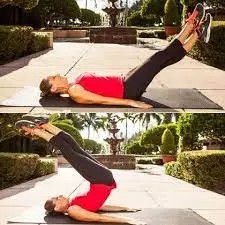
- Start with lying on your back and arms at the sides.
- Do the extension of both legs straight up to the ceiling.
- cross your right leg over your left, your toes should be pointed.
- Tighten your abs, take a breath, and bend your legs to a 45-degree angle.
- Pull your legs back into your body and raise them overhead at an angle, as though you’re trying to reach the point where the wall and ceiling meet behind you. Lift your hips and back off the ground and use your arms to support yourself as you do this.
- Maintain this for 1 count, and then gradually roll through the spine to the lower hips and take your legs back to the beginning position.
- That is 1 repitation.
- do again up to 3 sets of 10 repetitions.
Make it easier: If you are unable to raise your hips off the floor completely, take some time to strengthen your hips before attempting this challenging motion. To begin, try lifting your legs up and over and seeing if you can raise them just a few inches off the mat before lowering them back down.
Inching Elbow Plank
This plank will feel every bit as good in your arms and shoulders as it does in your stomach.
To do this exercise:
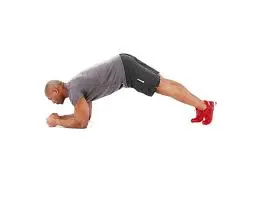
- Start with an elbow plank position, hands clasped, and feet slightly wider than hip-width distance.
- As you take a rapid step in with your right foot and raise your hips a little higher, step your left foot toward your hands.
- Step in with your left foot once more to raise your hips, then step in with your right foot once more to raise your hips even higher in a pike posture.
- Step back out slowly, turning your gait inside out, until you are back in the starting plank position.
- That is 1 repetition.
- Complete three sets of five reps at most.
To make it more difficult, take bigger steps to lift your hips higher in the pike position and up the rep count from five to ten every set.
Full Plank Passé Twist
With this exciting take on the classic plank, target those elusive obliques.
To do this exercise:
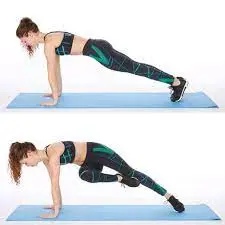
- Start in a full plank position and feet should be closer.
- As you slip your right foot up to the inside of your left knee to assume a passé position, bend your right knee across to the left.
- You should pivot slightly on the ball of your left foot and shift your hips to the left.
- Gradually slide the right leg back to the initiate position and then do it again to the left.
- That is 1 repetition.
- Do 3 sets of 10 repetitions
Frog Press
This lower ab exercise works your inner and outer thighs as well as your core.
To do this exercise:
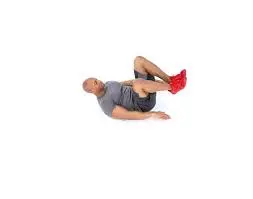
- Start by lying face up, flexing your feet, pressing your heels together, and bending and turning out your knees.
- Do the inhalation and raise your head and shoulders off the ground, curl up over the ribcage while looking at your legs.
- Reach arms outside of hips off of the ground, palms should be facing down.
- Squeeze the backs of your knees together as you stretch your legs 45 degrees and thrust out through your heels.
- Pull your heels back into your body after taking a breath.
- That is 1 repetition.
- Do again up to 3 sets of 10 repetitions.
To increase difficulty, lower your legs to the ground while you press out, or maintain both legs extended and turned out, then alternate between lifting and lowering them—just make sure your back stays down the entire time.
Dead Bug
A favored core exercise that works the hip flexors, transverse abdominis, and rectus abdominis is the dead bug exercise.
To do this exercise:
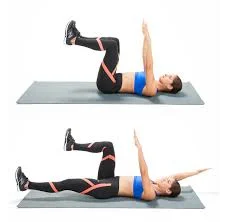
- Begin by lying face up with your legs in a tabletop position and your arms extended in the direction of the ceiling.
- Your knees need to be placed over your hips and bent 90 degrees.
- This is an initiate position.
- Gradually extend your right leg straight and lower your left arm overhead at the same time.
- maintain both a few inches from the ground.
- Throughout the entire workout, keep your core engaged and compress your glutes.
- Lower back pressed into the ground.
- Repeat the initiate position with your arm and leg extended.
- Do it again on the other side, extension of your left leg and your right arm.
Heel tap
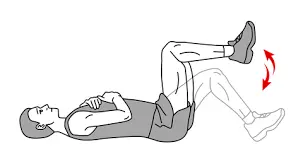
To do this exercise:
- Start with lying face up and your arms to your sides and your hands should be against the ground.
- Your knees should be bent, maintain your calves parallel to the ground.
- Gradually drop your flexed feet forward until your heels barely touch the ground.
- Compres your abs to help in lifting your feet back up to the initiate position.
- Make sure you complete 1 repetition for 30 seconds.
Mountain climber
This moderate-level exercise combines planking with knee movements, which is a perfect way to strengthen your core and balance.
To do this exercise:
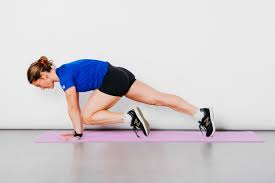
- Start with a plank, then place your hands beneath your shoulders.
- Your core muscle must be tightened.
- Raise your right knee toward your chest while keeping your back straight and your hips downward.
- Return your right leg to the starting position while simultaneously bringing your left knee up toward your chest.
- Continue simultaneously changing legs.
- Begin with 1 set of 8–12 repetitions.
- Complete 3 sets.
Slider pike
The Slider Pike is a challenging exercise that requires core strength and stability. It can help to improve lower abdominal strength and tone, as well as overall core stability.
To do this exercise:
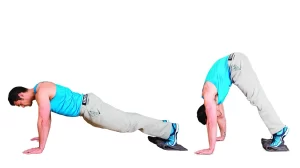
- To place under your feet, pick up some towels, coasters, or sliders.
- Initiate in the high plank position with both feet placed on the sliders.
- Lift your hips up toward the ceiling into a pike position by contracting your low abs and bringing your feet in towards your hands.
- Push your feet out gradually to bring your back to the beginning position.
- Repeat for 30 seconds.
Cross body climber
The Cross Body Climber is an exercise that targets the lower abdominal muscles, as well as the obliques and hip flexors. It is similar to a mountain climber, but with a twist that adds an extra challenge to the lower abs.
To do this exercise:
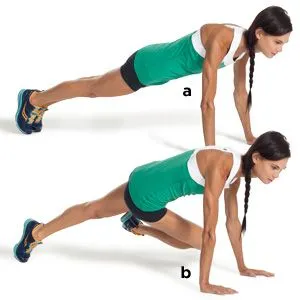
- Maintain a straight torso, level hips, and braced core to begin in the high plank position.
- Raise your right knee and bring it close to your left elbow.
- Lift your left leg and bring your left knee toward your right elbow as you bring your right leg back to the plank position.
- For thirty seconds, keep switching up your legs.
Slider knee tuck
The Slider Knee Tuck is an exercise that targets the lower abs by engaging the hip flexors and pulling the knees towards the chest. It is a variation of the traditional knee tuck but with the added challenge of using sliders to create a smooth, controlled movement.
To do this exercise:
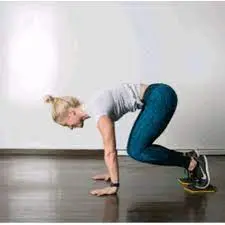
- To place under your feet, pick up some towels, coasters, or sliders.
- First, take a high plank position with both feet on the sliders.
- While keeping your core tight, bring both of your feet in closer to your chest. Avoid bending your upper body forward too much or hunching your shoulders.
- To get back to the starting position, push your feet back.
- In 30 seconds, perform as many times as you can.
Rolling plank
The Rolling Plank is another exercise that targets the lower abs by engaging the core muscles and challenging stability.
To do this exercise:
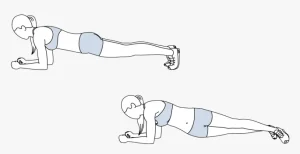
- Begin in a low plank pose propped up on your forearms.
- Maintain it for up to 10 seconds.
- Stack your feet as you roll onto your right elbow.
- Maintain the side plank for 10 seconds, while engaging your oblique muscles.
- Stack your feet and roll back through the center and onto your left elbow.
- Maintain for 10 seconds.
- For thirty seconds, keep alternating while maintaining your hip flexion and your core active.
Roll up
The roll-up is a challenging exercise that requires core strength and flexibility. It can help to improve lower abdominal strength and tone, as well as overall core stability and balance. It is also a low-impact exercise that is easy on the joints, making it a great option for people with knee or hip issues.
To do this exercise:
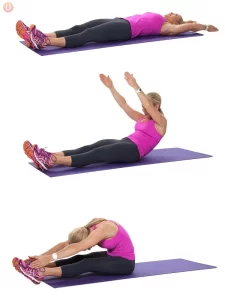
- Start with lying on your back and your legs should be extended, knees must be closer, feet flexed, and arms should be straight overhead.
- take a deep breath.
- Exhale, raise your arms in front of you, and then slowly roll up to a sitting position using your abs.
- Lower your back to the beginning position slowly while contracting your abs.
- Do it again as many times as you can in 30 seconds.
Jackknife
The Jackknife exercise is a highly effective movement that targets the lower abs. It involves a combination of crunches and leg raises to engage the entire core, with a particular focus on the lower abdominal muscles.
To do this exercise:
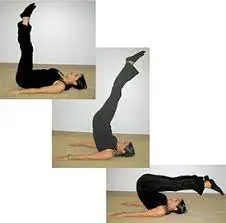
- Start with lying face up and your legs should be extended, feet closer, and arms lifted straight overhead.
- Take a deep inhalation.
- Squeeze your abs and elevate your both leg and right arm so that your hand touches your foot as you release the breath.
- Do the inhalation and gradually drop back to the initiate position.
- Do it again for 15 seconds.
- Make sure you complete 3 sets of this exercise.
Flutter kick
Flutter kicks are a popular exercise that specifically targets the lower abs and hip flexors. They involve a continuous kicking motion with your legs while lying flat on your back.
To do this exercise:
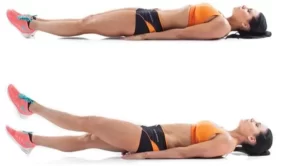
- Start with lying flat on your back and your legs should be extended straight out in front of you.
- Place your hands under your glutes to support your lower back.
- Engage your core muscles and lift your legs a few inches off the ground.
- Begin to alternate lifting each leg up and down, keeping them straight and close together.
- Keep your movements small and controlled, focusing on engaging your lower abs.
- Continue the flutter kicks for several repetitions or for a set amount of time.
Ab contraction
Ab contraction refers to the contraction or tightening of the abdominal muscles. It is an essential component of many exercises that target the core, including flutter kicks. When performing flutter kicks, engaging the abdominal muscles through ab contraction helps stabilize the body and maximize the effectiveness of the exercise.
To do this exercise:
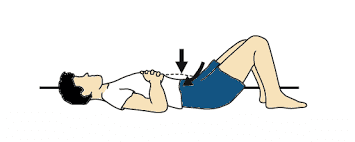
- start with lying on your back and your knees should be bent and your feet should be flat on the ground.
- Contract your core by pressing your navel into your spine with a slight movement while pressing your back into the ground.
- This is how you should contract and release your abdominal muscles for thirty seconds.
- Do the rest for a few seconds and do it again 1–3 times.
Throughout the activity, breathe deeply and slowly. If 30 seconds is too lengthy, try 10 or 15 first, then gradually extend it.
Hip lift
A hip lift is an exercise that specifically targets the lower abs. It involves lifting the hips off the ground while keeping the legs extended and straight.
To do this exercise:
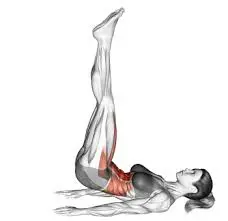
- Start with lying on your back and your arms should be extended alongside your body.
- Lift your legs so they are vertical.
- To lift your hips off the floor, press your feet up in the direction of the ceiling.
- Drop your hips back to the ground and do it again for a few repetitions.
- perform 1–3 sets of 10–15 repetitions.
Front leg raise
The front leg rise is an exercise that targets the lower abs, hip flexors, and quads.
To do this exercise:
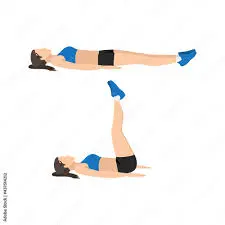
- Start with lying on your back and your legs should be straight and your arms must be at your sides.
- Lift one leg off the ground while maintaining a straight posture by using your core.
- Slowly raise your leg towards the ceiling, keeping it in line with your hip.
- Continue lifting your leg until it is perpendicular to the ground or until you feel a stretch in your lower abs.
- Maintain this position for a few seconds, then gradually drop your leg back down to the initiate position.
- Repeat for several repetitions, then switch sides and repeat with the other leg.
Split Stance Hinge With Reach
The Split Stance Hinge with Reach is an exercise that targets the lower abs while also engaging the hip flexors, glutes, and hamstrings. It involves a combination of a split stance position and a hinging movement, along with reaching forward to further engage the core.
To do this exercise:
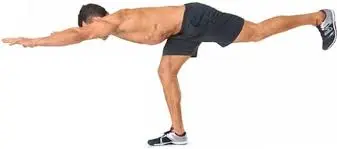
- Start with standing with your feet hip-width distance.
- Step back with your right foot two steps and lift your heel to create a kickstand-like balance on the ball of your foot.
- Stretch your arms forward until your biceps are near your ears and hinge forward at your hips with a flat back until your torso is parallel to the floor.
- Go back to standing while maintaining control.
- That is 1 repetition.
Side Plank With Crunch
The Side Plank with Crunch is an exercise that targets the lower abs while also engaging the obliques and the muscles of the core.
To do this exercise:
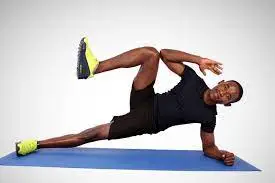
- Start with lying on your right side.
- Place your right elbow directly beneath your right shoulder, and your left foot should be placed on top of the right foot.
- Always ensure that your head and vertebrae are erect.
- Hold your left hand behind your head.
- Make sure you engage your core and raise your buttocks in the direction of the ceiling. This is the initiate position.
- Lift your right leg off the ground, flex your right knee, and simultaneously pull your left elbow and right knee close to each other, just like what you’d do during a bicycle crunch.
- Do the inhalation and put your right foot back on the ground.
- Perform this five times and then do a side plank on your left side.
- To perform a crunch, raise your left leg off the ground, flex your left knee, and bring your left knee and right elbow close to one another.
- Do the 2 sets of 5 repetitions on each side.
Benefits of lower abdominal exercise
Lower abs exercise, such as the front leg rise, can provide numerous benefits for the body. Here are some of the benefits of lower abs exercise in detail:
- Improved core strength: The lower abs are a part of the core muscles, which are responsible for stabilizing the spine and maintaining good posture. Strengthening the lower abs can improve overall core strength and stability.
- Better balance and coordination: Lower abs exercises can help improve balance and coordination by strengthening the muscles that support the pelvis and lower back.
- Reduced risk of injury: Strong lower abs can help prevent injury by providing support to the lower back and hips during physical activity.
- Improved athletic performance: Strong lower abs can improve athletic performance by providing a stable base for movements such as running, jumping, and lifting.
- Reduced back pain: Weak lower abs can contribute to lower back pain. Strengthening these muscles can help alleviate pain and discomfort in the lower back.
- Improved posture: Strong lower abs can help improve posture by supporting the spine and preventing slouching.
- Increased abdominal definition: Lower abs exercises can help tone and define the abdominal muscles, leading to a more sculpted appearance.
Overall, incorporating lower abs exercises into your workout routine can provide numerous benefits for your body, including improved core strength, better balance, and coordination, reduced risk of injury, improved athletic performance, reduced back pain, improved posture, and increased abdominal definition.
Risk factors of the lower abdominal exercises
Lower abs exercises can be highly effective in targeting the lower abdominal muscles, but they also come with certain risk factors that need to be considered. These risk factors include:
- Lower back strain: Many lower abs exercises involve lifting the legs or hips off the ground, which can put a strain on the lower back if not performed with proper form. This is especially true if the individual has weak core muscles or pre-existing lower back issues.
- Neck and shoulder strain: Some lower abs exercises require individuals to lift their upper body off the ground, which can lead to neck and shoulder strain if not executed correctly. Poor form, such as pulling on the neck or using the shoulders to lift, can increase the risk of injury.
- Hip flexor strain: Certain lower abs exercises, such as leg raises or reverse crunches, heavily engage the hip flexor muscles. Overuse or improper form can result in strain or tightness in these muscles, leading to discomfort or potential injury.
- Pelvic floor dysfunction: Individuals with weak pelvic floor muscles or those who are prone to pelvic floor dysfunction may experience worsening symptoms when performing intense lower abs exercises. This can include urinary incontinence, pelvic pain, or prolapse.
- Hernia risk: Individuals with a history of hernias or those at risk for developing hernias should exercise caution when performing lower abs exercises. The increased intra-abdominal pressure during these exercises can potentially worsen an existing hernia or lead to the development of a new one.
FAQ
Can lower abdominal exercises help with back pain?
Yes, strengthening the muscles in your lower abs can help support your lower back and reduce the risk of back pain. However, it is important to also incorporate exercises that target the entire core, as well as maintain good posture throughout the day.
Are there any risks associated with lower abdominal exercises?
As with any workout, if proper form and technique are not employed, there is a chance of injury. It is important to start slowly and gradually increase the intensity and duration of your workouts, as well as listen to your body and rest when necessary.
Can I do lower abdominal exercises if I have diastasis recti?
If you have diastasis recti (separation of the abdominal muscles), it is important to work with a healthcare professional or certified trainer who can provide modifications and ensure that you’re performing exercises safely and effectively.
Can I do lower abdominal exercises if I have a hernia?
If you have a hernia, it is important to work with a healthcare professional or certified trainer who can provide modifications and ensure that you’re performing exercises safely and effectively. In some cases, certain exercises may need to be avoided altogether.
Can lower abdominal exercises help me get a six-pack?
While lower abdominal exercises can help strengthen and tone the muscles in that area, it is important to note that spot reduction (targeting fat loss in a specific area) is not possible. It takes a combination of consistent exercise, healthy eating, and total body fat reduction to get a six-pack.
How often should I do lower abdominal exercises?
It is recommended to include lower abdominal exercises in your workout routine 2-3 times per week, allowing for rest days in between. Your muscles will have more time to recover and adjust to the workouts as a consequence.
Reference
- Smith, J. (2023, May 7). The Best Lower Ab Exercises for a Tight Core. Shape. https://www.shape.com/fitness/workouts/lose-pooch-best-exercises-lower-abs
- Hayes, A. (2023, September 26). Strengthen Your Lower Abs with These 10 Killer Moves. Men’s Health. https://www.menshealth.com/uk/health/a28675050/best-exercises-lower-abs/
- Watson, S. (2021, May 6). The Best Exercises for Your Lower Abs. Greatist. https://greatist.com/move/best-exercises-lower-abs
- Dias, A. (2023, April 29). 10 Lower Ab Exercises to Add to Your Fitness Routine. Healthline. https://www.healthline.com/health/exercise-fitness/lower-ab-workouts#hip-lift
- Dias, A. (2023, April 29). 10 Lower Ab Exercises to Add to Your Fitness Routine. Healthline. https://www.healthline.com/health/exercise-fitness/lower-ab-workouts#contractions
- 13 Best Lower Ab Workouts For Women To Get A Flat Belly. (2023, September 7). STYLECRAZE. https://www.stylecraze.com/articles/effective-lower-abs-workout-for-women/
- Image: Rogers, P. (2022, May 3). How to Do the Bird Dog Exercise: Proper Form, Variations, and Common Mistakes. Verywell Fit. https://www.verywellfit.com/how-to-do-the-bird-dog-exercise-3498253
- Image: U-Boat. (n.d.). skimble.com. https://www.skimble.com/exercises/41527-u-boat-how-to-do-exercise
- Image: Paoli, J. (n.d.). Pilates Exercise of the Month: The Jack Knife. https://sacdt.com/blog/2010/11/pilates-exercise-of-the-month-the-jack-knife/
- Image: Slider Knee Tuck. (n.d.). skimble.com. https://www.skimble.com/exercises/32826-slider-knee-tuck-how-to-do-exercise
- Image: Winer, J. (2021, December 16). Heel Taps. Niel Asher Education. https://nielasher.com/en-in/blogs/exercises-and-stretches/heel-taps
- Image: Frog Press – Muscle & Fitness. (2014, November 6). Muscle & Fitness. https://www.muscleandfitness.com/exercise/workouts/abs-and-core-exercises/frog-press/
- Image: Full Plank Passé Twist. (n.d.). skimble.com. https://www.skimble.com/exercises/41553-full-plank-pass%C3%A9-twist-how-to-do-exercise
- Image: Inching Elbow Plank – Muscle & Fitness. (2014, November 6). Muscle & Fitness. https://www.muscleandfitness.com/exercise/workouts/abs-and-core-exercises/inching-elbow-plank/
- Image: Reverse Plank Hover – Muscle & Fitness. (2014, November 6). Muscle & Fitness. https://www.muscleandfitness.com/exercise/workouts/abs-and-core-exercises/reverse-plank-hover/
- Image: T. E. (2012, October 13). the-exercist. Tumblr. https://the-exercist.tumblr.com/post/33523829157/criss-cross-lift-and-switch-how-to-do-it-lie-on
- Image: BODYWEIGHT 8: HIP HINGE – Men’s Health Your Body is Your Barbell: No Gym. Just Gravity. Build a Leaner, Stronger, More Muscular You in 28 Days! (n.d.). https://doctorlib.info/sport/mens-health-body/10.html
- Image: “Lying Leg Raises” Images – Browse 9 Stock Photos, Vectors, and Video. (n.d.). Adobe Stock. https://stock.adobe.com/in/search?k=%22lying+leg+raises%22
- Image: Leg Raise Hip Lift – A Unique Combination Exercise To Blast Your Lower Abs. (2018, January 6). Tom Venuto’s Burn the Fat Inner Circle – Weight Loss – Fat Loss – Support Community – Home of the Burn the Fat Challenge – Fat Burning Tips Workouts Recipes. https://www.burnthefatinnercircle.com/public/leg-raise-hip-lift-for-lower-abs.cfm
- Image: Rogers, P. (2023, July 5). How to Do a Reverse Crunch. Verywell Fit. https://www.verywellfit.com/how-to-do-the-crunch-3498607
- image: Resisted Single-Leg Stretch. (n.d.). skimble.com. https://www.skimble.com/exercises/41536-resisted-single-leg-stretch-how-to-do-exercise
- Image: 90-Degree Static Press. (n.d.). skimble.com. https://www.skimble.com/exercises/41535-90-degree-static-press-how-to-do-exercise

